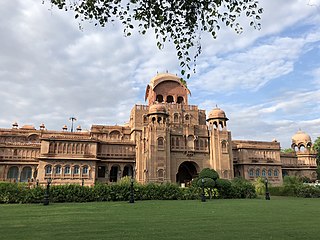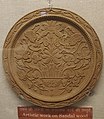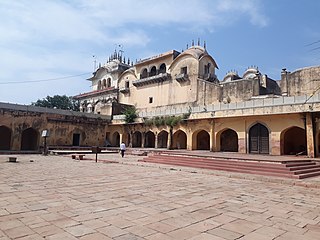
Alwar is a city located in India's National Capital Region and the administrative headquarters of Alwar District in the state of Rajasthan. It is located 150 km south of Delhi and 150 km north of Jaipur. At present the district is famous for production of Mustard Crop in the region, manufacturing of Ray Ban eyeglasses, Beer production plants and frozen food industry.

The Rajputana Agency was a political office of the British Indian Empire dealing with a collection of native states in Rajputana, under the political charge of an Agent reporting directly to the Governor-General of India and residing at Mount Abu in the Aravalli Range. The total area of the states falling within the Rajputana Agency was 127,541 square miles (330,330 km2), with eighteen states and two estates or chiefships.

Bikaner is a city in the northwest of the state of Rajasthan, India. It is located 330 kilometres (205 mi) northwest of the state capital, Jaipur. Bikaner city is the administrative headquarters of Bikaner District and Bikaner division. The Collector and District Magistrate of Bikaner is Sh. Bhagwati Prasad Kalal, and the Superintendent of Police is Tejaswini Gautam IPS.

Chhatri are semi-open, elevated, dome-shaped pavilions used as an element in Indo-Islamic architecture and Indian architecture. They are most commonly square, octagonal, and round. Originating as a canopy above tombs, they largely serve as decorative elements as opposed to functional elements. The earliest example of chhatri being used in the Indian Subcontinent were found in the Shrine of Ibrahim in Bhadreswar, constructed between 1159 and 1175 AD.

Rajput painting, painting of the regional Hindu courts during Mughal era, roughly from the end of the 16th-century to the middle of the 19th-century. Traditionally Rajput painting is further divided into Rajasthan and Pahari painting, that flourished in two different areas, "far apart from each other in terms of distance but all under the rule of Rajput chiefs, and bound together by a common culture".

The Kachhwaha, or Kachawa is a Rajput clan found primarily in India.

Alwar is a district in the state of Rajasthan in northern India, whose district headquarters is Alwar city. The district covers 8,380 km2. It is bound on the north by Rewari district of Haryana, on the east by Bharatpur district of Rajasthan and Nuh district of Haryana, on the south by Dausa district, and on the west by Jaipur district.

Junagarh Fort is a fort in the city of Bikaner, Rajasthan, India. Raja Dhaj, Ror Kumar, ruled over the principality of Junagarh in the fifth century BC. The fort was originally called Chintamani and was renamed Junagarh or "Old Fort" in the early 20th century when the ruling family moved to Lalgarh Palace outside the fort limits. It is one of the few major forts in Rajasthan which is not built on a hilltop. The modern city of Bikaner has developed around the fort.

The history of human settlement in the west Indian state of Rajasthan dates back to about 5,000 years ago. Around 1400 BC, the Matsya tribe occupied the region. Parts of Rajsthan also belonged to the site of the Indus Valley Civilization. The early medieval period saw the rise of many Rajput kingdoms such as the Chauhans of Ajmer, Sisodias of Mewar, Gurjara-Pratihara and the Rathores of Marwar, as well as several Rajput clans such as the Gohil and the Shekhawats of Shekhawati. While Jat kingdoms include the Johiya of Jangaldesh, the Sinsinwars of Bharatpur State, as well as the Bamraulia clan and the Ranas of Dholpur.

Kingdom of Sirohi or later Sirohi State was an independent Hindu state in present-day Rajasthan state of India. The state was founded in 1311 CE and lasted for six centuries until its peaceful dissolution in 1949 CE, when it merged into the erstwhile Bombay State of India.

The City Palace, Jaipur is a royal residence and former administrative headquarters of the rulers of the Jaipur State in Jaipur, Rajasthan. Construction started soon after the establishment of the city of Jaipur under the reign of Maharaja Sawai Jai Singh II, who moved his court to Jaipur from Amber, in 1727. Jaipur remained the capital of the kingdom until 1949—when it became the capital of the present-day Indian state of Rajasthan—with the City Palace functioning as the ceremonial and administrative seat of the Maharaja of Jaipur. The construction of the Palace was completed in 1732 and it was also the location of religious and cultural events, as well as a patron of arts, commerce, and industry. It was constructed according to the rules of vastushastra, combining elements of Mughal and Rajput architectural styles. It now houses the Maharaja Sawai Man Singh II Museum, and continues to be the home of the Jaipur royal family. The royal family has around 500 personal servants. The palace complex has several buildings, various courtyards, galleries, restaurants, and offices of the Museum Trust.The MSMS II Museum Trust is headed by chairperson Rajamata Padmini Devi of Jaipur. Princess Diya Kumari runs the Museum Trust, as its secretary and trustee. She also manages The Palace School and Maharaja Sawai Bhawani Singh School in Jaipur. She founded and runs the Princess Diya Kumari Foundation to empower underprivileged and underemployed women of Rajasthan. She is also an entrepreneur. In 2013, she was elected as Member of the Legislative Assembly of Rajasthan from the constituency of Sawai Madhopur.

Naruka is a clan of Rajputs found in India. Naruka Rajputs are offshoots of Maharao Naru Singh of Mozamabad, whose grandfather, Rao Bar Singh, gave up the throne of Amer kingdom. Rao Bar Singh was the eldest son of Raja Udaikarna of Amer. Naruka is the most prominent clan among Kachhwaha and holds an exceptional position in the history of India. They independently ruled on Alwar State.

Bundi State was founded by Hada Rao Devda currently located in modern-day Rajasthan. It was ruled by Hada Chauhans Rajputs.

Alwar State was a kingdom from 1770 to 1818 and a princely state under British rule from 1818 to 1947. Initially its capital was Macheri and then the city of Alwar. The nobility of Alwar State belonged to the Naruka branch of the Kachwaha dynasty. The kingdom was established by Naruka chief Rao Raja Pratap Singh in 1770 CE. Alwar State was one of the 19 princely states of former-Rajputana, which existed at the time of Indian Independence. The last reigning ruler, Maharaja Sir Tej Singh Prabhakar Bahadur, signed the accession to the Indian Union on 7 April 1949.

Lawa Thikana was a Thikana estate or Thakurat under the Jaipur Residency of the former Rajputana Agency. It was ruled by Naruka Rajputs. It was located very close to Tonk town and included its capital, Lawa, a small town and its surroundings. Lawa is located in the northwestern part of present-day Tonk district of Rajasthan, India.
Events in the year 1707 in India.
The Badgujar / Bargujar / Badgurjar is a clan of Rajputs. They are also a distinct caste in Maharashtra.
The Sardar Government Museum is located in Public Park, Jodhpur, Rajasthan, India. The museum is named in memory of Maharaja Sardar Singh, a ruler of Jodhpur from 1895 to 1911. It was constructed under the reign of his son, Maharaja Umed Singh. It was built by Henry Vaughan Lanchester in 1909 and formally opened to the public on 17 March, 1936. The area of the museum is approx. 18,000 sq.ft. On 22 June 2018, the re-planned museum was inaugurated by Smt. Vasundhara Raje, the Chief Minister of Rajasthan.
Narukhand refers to the historical territories which remained under the possession of Naruka Rajputs. Literally, Narukhand means "the country of Naruka Rajputs".




























